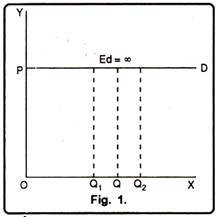Dr. Marshall has pro-founded the concept of price elasticity of demand. In simple words, price elasticity of demand is the ratio of percentage change in quantity demanded to the percentage change in price.
In other words, price elasticity of demand is a measure of the relative change in quantity purchased of a good in response to a relative change in its price. It is thus, rate at which the demand changes to the given change in prices.
So, we can say that it is the rate or the degree of response in demand to the change in price.
Therefore, the co-efficient of price elasticity of demand can be written as below:
Definitions:
The concept of price elasticity of demand has been defined by different economies as under:
“Elasticity of demand may be defined as the percentage change in quantity demanded to the percentage change in-price.”
“Elasticity of demand is the ratio of relative change in quantity to relative change in Price.”
“ The elasticity of demand for a commodity is the rate at which quantity bought change the price change.”
ADVERTISEMENTS:
“The elasticity of demand is a measure of the relative change in quantity to a relative change in price”.
“Elasticity of demand measures the responsiveness of demand to changes in price”.
Degrees of Price Elasticity:
Different commodities have different price elasticity’s. Some commodities have more elastic demand while others have relative elastic demand. Basically, the price elasticity of demand ranges from zero to infinity. It can be equal to zero, less than one, greater than one and equal to unity.
“The elasticity or responsiveness of demand in a market is great or small according as the amount demanded increases much or little for a given fall in price and diminishes much or little for a given rise in price”.
ADVERTISEMENTS:
However, some particular values of elasticity of demand have been explained as under:
1. Perfectly Elastic Demand:
Perfectly elastic demand is said to happen when a little change in price leads to an infinite change in quantity demanded. A small rise in price on the part of the seller reduces the demand to zero. In such a case the shape of the demand curve will be horizontal straight line as shown in figure 1.
The figure 1 shows that at the ruling price OP, the demand is infinite. A slight rise in price will contract the demand to zero. A slight fall in price will attract more consumers but the elasticity of demand will remain infinite (ed=∞). But in real world, the cases of perfectly elastic demand are exceedingly rare and are not of any practical interest.
2. Perfectly Inelastic Demand:
Perfectly inelastic demand is opposite to perfectly elastic demand. Under the perfectly inelastic demand, irrespective of any rise or fall in price of a commodity, the quantity demanded remains the same. The elasticity of demand in this case will be equal to zero (ed = 0).
In diagram 2 DD shows the perfectly inelastic demand. At price OP, the quantity demanded is OQ. Now, the price falls to OP1, from OP, the demand remains the same. Similarly, if the price rises to OP2 the demand still remains the same. But just as we do not see the example of perfectly elastic demand in the real world, in the same fashion, it is difficult to come across the cases of perfectly inelastic demand because even the demand for, bare essentials of life does show some degree of responsiveness to change in price.
3. Unitary Elastic Demand:
The demand is said to be unitary elastic when a given proportionate change in the price level brings about an equal proportionate change in quantity demanded. The numerical value of unitary elastic demand is exactly one i.e. Marshall calls it unit elastic.
In figure 3, DD demand curve represents unitary elastic demand. This demand curve is called rectangular hyperbola. When price is OP, the quantity demanded is OQ\. Now price falls to OP1 the quantity demanded increases to OQ2. The area OQ\RP = area OP\SQ2 in the fig. denotes that in all cases price elasticity of demand is equal to one.
4. Relatively Elastic Demand:
ADVERTISEMENTS:
Relatively elastic demand refers to a situation in which a small change in price leads to a big change in quantity demanded. In such a case elasticity of demand is said to be more than one (ed > 1). This has been shown in figure 4.
In fig. 4, DD is the demand curve which indicates that when price is OP the quantity demanded is OQ1. Now the price falls from OP to OP1, the quantity demanded increases from OQ1 to OQ2 i.e. quantity demanded changes more than change in price.’
5. Relatively Inelastic Demand:
ADVERTISEMENTS:
Under the relatively inelastic demand, a given percentage change in price produces a relatively less percentage change in quantity demanded. In such a case elasticity of demand is said to be less than one (ed < 1). It has been shown in figure 5.
All the five degrees of elasticity of demand have been shown in figure 6. On OX axis, quantity demanded and on OY axis price is given.
It shows:
ADVERTISEMENTS:
1. AB — Perfectly Inelastic Demand
2. CD — Perfectly Elastic Demand
3. EG — Less than Unitary Elastic Demand
4. EF — Greater Than Unitary Elastic Demand
5. MN — Unitary Elastic Demand.





